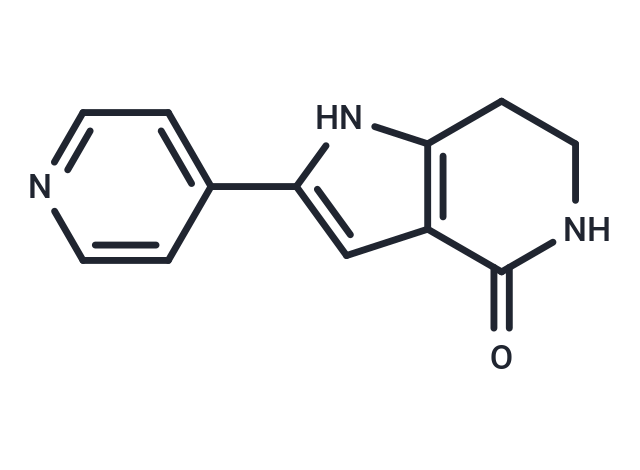Shopping Cart
- Remove All
 Your shopping cart is currently empty
Your shopping cart is currently empty

PHA-767491 (CAY10572) is a potent ATP-competitive dual Cdc7/CDK9 inhibitor with IC50 of 10 nM and 34 nM, respectively.

| Pack Size | Price | Availability | Quantity |
|---|---|---|---|
| 2 mg | $30 | In Stock | |
| 5 mg | $45 | In Stock | |
| 10 mg | $63 | In Stock | |
| 25 mg | $107 | In Stock | |
| 50 mg | $157 | In Stock | |
| 100 mg | $232 | In Stock | |
| 200 mg | $345 | In Stock | |
| 1 mL x 10 mM (in DMSO) | $45 | In Stock |
| Description | PHA-767491 (CAY10572) is a potent ATP-competitive dual Cdc7/CDK9 inhibitor with IC50 of 10 nM and 34 nM, respectively. |
| Targets&IC50 | CDC7:10 nM, CDK9:34 nM |
| In vitro | PHA-767491 reduces Chk1 phosphorylation and increases in situ apoptosis in tumor tissues from nude mouse HCC xenograft slices. |
| In vivo | PHA-767491 inhibits cell proliferation in two cell lines, achieving IC50 values of 0.64 μM in HCC1954 cells and 1.3 μM in Colo-205 cells. Additionally, PHA-767491 (2 μM) completely abolishes Mcm2 phosphorylation in HCC1954 cells within 24 hours. In combination with 5-FU, PHA-767491 exhibits enhanced cytotoxic effects in HCC cells, inducing significant apoptosis characterized by increased activation of caspase-3 and poly (ADP-ribose) polymerase fragmentation. It directly counteracts 5-FU-induced phosphorylation of Chk1 and reduces the expression of the anti-apoptotic protein, myeloid cell leukemia sequence 1 (Mcl-1). Furthermore, PHA-767491 (0-10 μM) reduces the viability of glioblastoma cells in a time- and dose-dependent manner, with IC50 values around 2.5 μM in U87-MG and U251-MG cells. |
| Kinase Assay | 20 ng of purified human DDK, together with increasing concentrations of each DDK inhibitor is pre-incubated for 5 min. Then 10 μCi (γ)-32P ATP and 1.5 μM cold ATP are added in a buffer containing 50 mM Tris-HCl (pH 7.5), 10 mM MgCl2, and 1 mM DTT and incubated for 30 min at 30°C. The proteins are denatured in 1X Laemmli buffer at 100°C followed by SDS-PAGE and autoradiography on HyBlot CL film. DDK kinase activity is indicated by Auto-phosphorylation of DDK. 32P-labeled bands are quantified using ImageJ and the IC50 values are calculated using GraphPad. |
| Cell Research | For assays in 96 well plates 2500 cells are plated per well. After 24 hours, cells are treated with small molecule inhibitors and incubated for 72 hours at 37°C. Subsequently the cells are lysed and the ATP content is measured as an indicator of metabolically active cells using the CellTiter-Glo assay. IC50 values are calculated using the GraphPad software. For assays in six well plates, 100,000 cells are plated per well. After 24 hours, cells are treated with small molecule inhibitors and incubated for varying time points. Cells are trypsinized and a suspension is made in 5 mL of phosphate buffered saline. 30 μL of this suspension is mixed with 30 μL of CellTiter-Glo reagent followed by a 10-minute incubation at room temperature. Luminescence is measured using EnVision 2104 Multilabel Reader and BioTek Synergy Neo Microplate Reader. |
| Alias | PHA767491, PHA 767491, CAY10572 |
| Molecular Weight | 213.24 |
| Formula | C12H11N3O |
| Cas No. | 845714-00-3 |
| Smiles | O=C1C=2C=C(NC2CCN1)C=3C=CN=CC3 |
| Relative Density. | 1.287 |
| Storage | Powder: -20°C for 3 years | In solvent: -80°C for 1 year | Shipping with blue ice. | |||||||||||||||||||||||||||||||||||
| Solubility Information | H2O: < 1 mg/mL (insoluble or slightly soluble) DMSO: 40 mg/mL (187.58 mM), Sonication is recommended. Ethanol: < 1 mg/mL (insoluble or slightly soluble) | |||||||||||||||||||||||||||||||||||
Solution Preparation Table | ||||||||||||||||||||||||||||||||||||
DMSO
| ||||||||||||||||||||||||||||||||||||

Copyright © 2015-2025 TargetMol Chemicals Inc. All Rights Reserved.